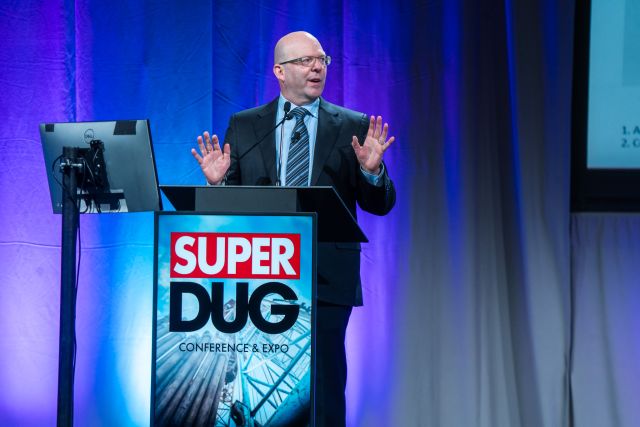
Nick McKenna, ConocoPhillips' vice president of the Midland Basin, during Hart Energy’s SUPER DUG conference in Fort Worth, Texas. (Source: Hart Energy)
ConocoPhillips has built a diversified portfolio in the Lower 48, but the company will rely on the Permian Basin to fuel increased volumes, said Nick McKenna, the company’s vice president of the Midland Basin, during Hart Energy’s SUPER DUG Conference & Expo in Fort Worth, Texas.
Houston-based ConocoPhillips is relying on diversity in its Lower 48 plays, including the Eagle Ford and the Bakken, to sustain production and grow cash flow, with the Permian serving in particular as a key growth engine for the Lower 48 and for the company,” McKenna said May 15 during the event.
ConocoPhillips has about 1.7 million net unconventional acres across Lower 48, including 562,000 net acres in the Bakken; 199,000 acres in the Eagle Ford; 248,000 in the Midland Basin; and 654,000 in the Delaware Basin. The company has roughly 6,000 locations that breakeven at or below $50/bbl.
The company has made strides in efficiency in its plays, including improving Permian drilling efficiencies by about 50% since 2019.
ConocoPhillips has also upped its use of recycled water in Permian operations to 52% in 2022 compared to 11% in 2019.
“We have reduced our associated gas flaring by 80% since 2019 and do not routinely flare due to pipeline constraints in the Lower 48 or anywhere else in the portfolio. In the Permian, over 50% of our water for hydraulic fracturing has been recycled to produce water, and we're working to increase that as well,” McKenna said. “All these reductions to improve the sustainability of our assets translates to lowering well costs, lowering our cost of supply.”
McKenna said ConocoPhillips’ average cost of supply across its Lower 48 drilling program was $32/bbl, allowing the company to drive cash flow growth as well as returns.
McKenna stressed during his presentation that “the cost of supply is not a breakeven metric, it's a returns metric.”
RELATED
ConocoPhillips Looks to Scale Portfolio, But Citgo Auction Not a Factor
McKenna said ConocoPhillips had a high-quality diversified global portfolio—“diversified in terms of product mix, asset class, conventional and unconventional production.”
On LNG, McKenna said it would play an increasingly crucial role in the global energy mix as a reliable and dispatchable low-carbon fuel.
Specifically, McKenna said U.S. sourced LNG, which uses Permian feed gas, offers Germany an over 40% reduction in emissions for power generation compared to coal. He said those emissions benefits were similar when delivered into Asia.
Recommended Reading
Not Sweating DeepSeek: Exxon, Chevron Plow Ahead on Data Center Power
2025-02-02 - The launch of the energy-efficient DeepSeek chatbot roiled tech and power markets in late January. But supermajors Exxon Mobil and Chevron continue to field intense demand for data-center power supply, driven by AI technology customers.
Lion Equity Partners Buys Global Compression from Warren Equipment
2025-01-09 - Private equity firm Lion Equity Partners has acquired Warren Equipment Co.’s Global Compression Services business.
SM Energy Adds Petroleum Engineer Ashwin Venkatraman to Board
2024-12-04 - SM Energy Co. has appointed Ashwin Venkatraman to its board of directors as an independent director and member of the audit committee.
Chevron Targets Up to $8B in Free Cash Flow Growth Next Year, CEO Says
2025-01-08 - The No. 2 U.S. oil producer expects results to benefit from the start of new or expanded oil production projects in Kazakhstan, U.S. shale and the offshore U.S. Gulf of Mexico.
Michael Hillebrand Appointed Chairman of IPAA
2025-01-28 - Oil and gas executive Michael Hillebrand has been appointed chairman of the Independent Petroleum Association of America’s board of directors for a two-year term.
Comments
Add new comment
This conversation is moderated according to Hart Energy community rules. Please read the rules before joining the discussion. If you’re experiencing any technical problems, please contact our customer care team.





